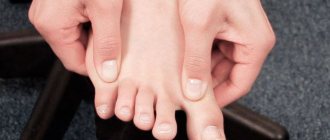Schizophrenia has many varieties. It is classified according to the rate of progression, characteristic symptoms, intensity of symptoms and other characteristics. In total, this pathology affects 0.5-1% of the population. One of its rare subtypes is hebephrenic schizophrenia. It is detected in 5% of patients with similar disorders. We will tell you what the features of hebephrenia are, how it arises, develops and is treated.
In this article
- History and main features
- Causes
- Symptoms
- Clinical cases
- Diagnostics
- Treatment
- Forecast
History and main features
The term “hebephrenic paraphrenia” was first used in 1871 by Ewald Hecker. In describing this disorder, he mentioned that it is “a special form of terminal dullness, the signs of which can be recognized in the early stages of the disease.” The pathology received its name in honor of the ancient Greek goddess of youth Hebe.
Today, the equivalent concepts of “hebephrenic schizophrenia”, “hebephrenic schizophrenia” and “hebephrenia” are used. You can also come across the term “schizophrenia of the disorganized type.” It is outdated, but in the literature you can still find the formulation “disorganized schizophrenia.”
The main feature of this disease is that the patient behaves like a child, even if he is an adult. In general, his behavior is inappropriate, foolish and mannered. Sometimes it is very ridiculous and obscene. The patient constantly giggles, smiles smugly, grimaces and plays pranks.
The onset of pathology usually occurs at 15-25 years of age. Residents of large cities often suffer from it. The incidence of development in women and men is approximately the same. The disease is not common. In its pure form, that is, without signs of other forms and types of schizophrenia, it is observed in only 5% of patients.
The schizophrenic defect in hebephrenia develops quickly, the pathology progresses rapidly, and is difficult to treat. There is a high probability that the patient will lose his purpose in life, and his existence will become meaningless.
Advice for relatives of someone with schizophrenia
Schizophrenia is a serious illness, both for the person himself and for his close circle. However, if a person is not able to understand that he is sick, the family is simply obliged to recognize the disease and seek help from a psychiatrist. It's time to dispel existing stereotypes that it is impossible to help a person with schizophrenia. Maybe. With properly selected therapy, long-term, high-quality remissions are achieved with full restoration of ability to work over a long period of time. The main thing is to recognize the disease in time and begin treatment. If this is not done, the person will usually face emergency hospitalization in a state of psychosis. Don't wait until the worst happens to take action. Relatives are the only people who can change the life of a person with schizophrenia for the better. The quality of life of patients suffering from this disease largely depends on their support and their participation in the recovery process. If you suspect someone close to you has schizophrenia, contact a psychiatrist immediately.
We also recommend reading the article about low-grade schizophrenia.
Causes
Doctors name several reasons that could hypothetically lead to or provoke hebephrenia:
- genetic abnormalities;
- fetal hypoxia;
- intrauterine infections;
- epilepsy;
- childhood psychological trauma.
These are predisposing factors. It is clear that it is difficult to call them direct culprits, since their presence only increases the risk of developing the hebephrenic form of schizophrenia. The impetus for the appearance of the first signs may be:
- child abuse;
- unhealthy atmosphere in the family;
- constant stress;
- bullying at school;
- brain diseases of various etiologies;
- alcohol and drug use.
Medical practice shows that patients with hebephrenia in infancy have low weight, low intelligence and strong involuntary reactions to stimuli.
Also, children who are subsequently diagnosed with hebephrenic schizophrenia differ in:
- persistent antisocial characteristics;
- overly exemplary behavior;
- dependence on adults;
- increased sensitivity;
- lack of communication;
- reluctance to perform mental work;
- general lethargy and passivity.
In addition, patients with hebephrenia experience early sexual intercourse, problems with the law, and other antisocial behavior. They are prone to rebellion, disobedience, and drug and alcohol use. In other words, they behave deviantly.
Symptoms
The onset of the disease is difficult to distinguish from bad or ill-mannered behavior. The patient is fooling around, making faces and saying stupid things. But outsiders should be wary of the complete lack of logic in his words and actions. He also often complains of various illnesses, which indicates hypochondria. Sometimes a person can be aggressive. In general, his mood is excessively elevated, but is often replaced by apathy.
The main symptoms of hebephrenic schizophrenia:
- Disorganized thinking. The patient cannot formulate and logically justify his thoughts. Because of this, he jumps from one topic to another, without being able to stop at one thing. In some cases, his speech is so confused and incomprehensible that others perceive it as a set of sounds.
- Disorganized behavior. A patient with hebephrenia may constantly make some movements, as if he has nowhere to put his hands. He puts them behind his head, straightens his socks, scratches himself, knocks on the table with his fingers, etc. In severe cases, he is unable to perform ordinary everyday activities - wash, shave, get dressed. Some patients behave childishly and stupidly, but sometimes they behave aggressively.
- Sexual deviation. We are talking about displaying genitals and defecating in public places. Also, patients with hebephrenia love to joke obscenely, and at the level of an eighth-grader who giggles in biology lessons. In general, the sexual topic is of great interest to the patient, like any child during puberty.
- Inadequacy of emotions. The patient can be either overexcited or extremely apathetic. Sometimes his face shows no emotion at all, as if he feels nothing. But at the same time, at any moment he can laugh out loud, and in any place, for example, in a lesson or an important event.
- Misconceptions With hebephrenic schizophrenia, a person may be at the mercy of false beliefs that are formed as delusions. It seems to him that he is a great person or that someone is constantly chasing him.
- Self-isolation. Gradually the number of contacts with people is reduced. The patient interacts less and less with others, including loved ones. It is not only the lack of interest on the part of the patient that interferes, but also poor social skills.
- Unawareness. In this case, we are talking about the fact that the patient does not consider himself sick. At the same time, he can easily explain his condition or stay in the clinic: “my parents wanted it,” “the doctor advised me,” “the pills are making me a fool,” etc.
Most often, relatives of the patient turn to doctors, since the latter considers himself “normal.”
Delusions and hallucinations, which are typical signs of almost any schizophrenia, may be absent in hebephrenia.
In severe forms, catatonic and manic syndromes, delusions, hallucinations and severe hypochondria are observed. Symptoms such as depersonalization and derealization may be recorded, when the world around us seems unreal. Foolishness gives way to apathy, speech becomes more and more meager and primitive over time. Some patients become very interested in religion, philosophy, or a narrower topic, for example, the work of the subway.
Typical forms of the disease
Typical forms of schizophrenia include paranoid, hebephrenic, catatonic and simple forms.
Paranoid form (F20.0)
Most often in their practice, psychiatrists encounter the paranoid form of schizophrenia. In addition to the main signs of schizophrenia (impaired thinking, autism, decreased emotions and their inadequacy), the clinical picture of this form is dominated by delirium. It typically manifests as delusions of persecution without hallucinations, delusions of grandeur, or delusions of influence. Signs of mental automatism may occur when patients believe that someone from the outside is influencing their own thoughts and actions.
Hebephrenic form (F20.1)
The most malignant form of schizophrenia is hebephrenic. This form is characterized by manifestations of childishness and silly, absurd excitement. Patients grimace, can laugh for no reason, and then suddenly become indignant, show aggression and destroy everything in their path. Their speech is inconsistent, full of repetitions and words they have invented, and very often accompanied by cynical abuse. The disease usually begins in adolescence (12-15 years) and progresses rapidly.
Catatonic form (F20.2)
The clinical picture of the catatonic form of schizophrenia is dominated by motor dysfunction. Patients remain in unnatural and often uncomfortable positions for long periods of time without feeling tired. They refuse to follow instructions and do not answer questions, although they understand the words and commands of the interlocutor. Immobility in some cases (catalepsy, a symptom of a “mental (air) cushion”) is replaced by attacks of catatonic excitement and impetuous actions. In addition, patients can copy facial expressions, movements and statements of their interlocutor.
Simple form (F20.6)
The simple form of schizophrenia is characterized by an increase in exclusively negative symptoms, in particular, apathetic-abulic syndrome. It is manifested by emotional poverty, indifference to the world around us, indifference to oneself, lack of initiative, inactivity and rapidly increasing isolation from the people around us. At first, a person refuses to study or work, breaks off relationships with relatives and friends, and wanders. Then, gradually, he loses his accumulated knowledge and develops “schizophrenic dementia.”
Atypical forms of the disease
In the clinic of atypical forms of schizophrenia, non-standard, not entirely characteristic signs predominate. Atypical forms include schizoaffective psychosis, schizotypal disorder (neurosis-like and variant), febrile schizophrenia and some other forms of schizophrenia.
Schizoaffective psychosis (F 25)
Schizoaffective psychosis is a special condition that is characterized by the paroxysmal occurrence of schizophrenic (delusional, hallucinatory) and affective symptoms (manic, depressive and mixed). These symptoms develop during the same attack. At the same time, the clinical picture of the attack does not meet either the criteria for manic-depressive psychosis or the criteria for schizophrenia.
Schizotypal disorder (neurosis-like variant) (F 21)
The neurosis-like variant of schizotypal disorder is manifested by asthenic, hysterical symptoms or obsessive phenomena that resemble the clinic of the corresponding neuroses. However, neurosis is a psychogenic reaction to a traumatic situation. Schizotypal disorder is a disease that occurs spontaneously and does not correspond to existing frustrating experiences. In other words, it is not a response to a stressful situation and is characterized by absurdity, deliberateness, and isolation from reality.
Febrile schizophrenia
In extremely rare cases, acute psychotic states with signs of severe toxicosis occur, called febrile schizophrenia. Patients experience a high temperature, and the symptoms of somatic disorders increase (subcutaneous and intraorgan hemorrhages, dehydration, tachycardia, etc.). The clinic of mental disorders is characterized by clouding of consciousness, the appearance of delusions of fantastic content and catatonic syndrome. Patients are confused, rush around in bed, make meaningless movements, cannot say who they are and where they are. Febrile schizophrenia should be distinguished from neuroleptic malignant syndrome. This is a fairly rare life-threatening disorder associated with the use of psychotropic drugs, most often antipsychotics. Neuroleptic malignant syndrome is usually manifested by muscle rigidity, increased body temperature, autonomic changes and various mental disorders.
Rare forms of delusional psychoses
Rare forms of delusional psychoses include chronic delusional disorders (paranoia, late paraphrenia, etc.), acute transient psychoses.
Chronic delusional disorders (F22)
This group of psychoses includes various disorders in which chronic delusions are the only or most noticeable clinical sign. The delusional disorders observed in patients cannot be classified as schizophrenic, organic or affective. It is likely that the reasons for their occurrence are genetic predisposition, personality traits, life circumstances and other factors. Chronic delusional disorders include paranoia, tardive paraphrenia, paranoid psychosis, and paranoid schizophrenia with sensitive relational delusions.
Paranoia (F22.0)
Patients suffering from paranoia are often suspicious, touchy, and jealous. They tend to see the machinations of ill-wishers in random events, remember grievances for a long time, do not accept criticism, and treat the people around them with acute distrust. Often they have overvalued delusional ideas of grandeur and/or persecution, on the basis of which patients are able to build complex logical conspiracy theories directed against themselves. Often those suffering from paranoia write a huge number of complaints against imaginary ill-wishers to various authorities, and also begin lawsuits.
Acute transient psychoses (F23)
The clinical picture of acute transient psychosis develops after a fleeting period of confusion, anxiety, restlessness and insomnia. Psychosis is characterized by the appearance of acute sensory delirium with rapid changes in its structure. Most often, delusional ideas of influence, persecution, relationships, staging, false recognition and delusions of a double arise. Hallucinatory experiences, true auditory and pseudohallucinations are possible. As a rule, they are unstable and prone to changing each other quickly.
Clinical cases
With hebephrenic schizophrenia, the patient does not feel shame, he has no sense of responsibility or caution. He may behave defiantly, ask tactless questions without expecting an answer, giggle and use foul language. Almost constantly, such patients laugh at their own jokes. Moreover, their laughter seems unnatural, childish, feigned.
A typical example is the development of hebephrenia in a 14-year-old teenager. Until this age, he was diligent and obedient, studied well, and was raised in a complete family without relatives with mental disorders. During puberty, behavior deteriorated.
The patient stopped attending school, wandered around the city, undressed and pestered passers-by, began to smoke and drink alcohol. He categorically refused hygiene procedures, was often rude, showed his genitals to others, and attempted to defecate in the middle of the room. He was forcibly hospitalized.
Another example is a 19-year-old boy. I was admitted to the clinic with the typical symptoms of hebephrenia described earlier. During conversations with the doctor, he constantly made faces and periodically inserted obscene jokes into his speech. In general, I reasoned relatively normally. He remembered the dates and talked enthusiastically about the metro system. When I tried to remember all the stations, I got confused. The doctor tried to change the conversation to another topic, but the patient showed signs of aggression.
The patient believed that the state paid him a very small disability benefit, and the pills made him “a fool.” During the conversation with the doctor, he always moved his hands and fidgeted in place. Demonstrated the behavior of a 10-year-old child. To the question “why is he in the clinic?” answered that he was “crazy.”
The third example is a 16-year-old teenager. He was raised by his mother, and a very suspicious woman. One of the relatives was treated in a psychiatric clinic. He developed normally until the age of 12. He showed success at school, was distinguished by curiosity, and had good characteristics.
However, the teenager suddenly became rude and disobedient. At the age of 14, I began to develop very quickly physically. Signs of sexual deviation appeared. He began to consider himself a freak, made faces in front of the mirror for a long time, and became addicted to gambling.
Over time, he became more and more undisciplined, hypochondria developed - he forbade his mother to touch food, as he was afraid of infection. He was hospitalized at the age of 16 from the street when he was walking around naked.
Periodic (recurrent) schizophrenia
With this type of schizophrenia, attacks of productive mental disorders occur periodically and are not accompanied by profound personality changes. Their number varies. Some people have one attack in their entire life, others have several, and others have more than ten. Attacks of schizophrenia can last from several days to several months. They can be of the same type (similar to each other) or heterogeneous (dissimilar to each other). The medical and social prognosis for periodic schizophrenia is usually quite favorable. This is explained by the insignificant severity of negative personal changes or their absence due to persistent intermission or practical recovery. The prognosis worsens with the severity, lengthening and frequency of attacks of recurrent schizophrenia.
Diagnostics
To accurately diagnose hebephrenic schizophrenia, you will have to observe the patient in a hospital for several weeks or months, depending on the condition for which the patient was hospitalized. As a rule, the question of hebephrenia arises when the foolishness does not go away within a month from the first day of observation. The following criteria are also used:
- there are no obvious delusions or hallucinations;
- there is a speech disorder;
- there are signs of mindless behavior.
It is important to carry out differential diagnosis. First, tumors of the frontal lobes of the brain, infectious inflammation, dementia due to Pick's disease (atrophy of brain structures) and Huntington's chorea (a disease of the nervous system) should be excluded. For this purpose, CT, MRI, EEG and fundus examination are prescribed.
If schizophrenia is suspected, the medical histories of relatives are always checked, since this pathology is often genetically determined.
Secondly, it is necessary to differentiate hebephrenic schizophrenia from hebephrenic syndrome, which can develop both within schizophrenia and as a separate disease against the background of epilepsy. The syndrome occurs with hallucinations, delusions and catatonia, and is also characterized by the following symptoms:
- contraction of facial muscles, grimacing;
- lack of motives in actions;
- causeless euphoria, elation.
The syndrome can lead to the development of schizophrenia or occur against its background, but this is not necessary. It all depends on how early treatment began.
Thirdly, it is necessary to distinguish hebephrenia from heboid psychopathy, which has similar symptoms, but occurs in a milder form.
Paroxysmal-progressive schizophrenia
The most common paroxysmal-progressive course of schizophrenia occurs. This variant of the course is characterized by the presence of episodic attacks of schizophrenia with incomplete, low-quality remissions. Each attack leads to a personality defect, as well as increased delusions and hallucinations. The degree of progression of fur coat-like schizophrenia and the depth of the mental defect may vary. The clinical and social prognosis of this type of schizophrenia is determined by the rate of increase in personality changes, as well as the duration, frequency and severity of attacks. Fur-like schizophrenia with a rapidly developing mental defect has an unfavorable prognosis. A relatively favorable prognosis for sluggish fur-like schizophrenia. It is characterized by the rare occurrence of attacks that are non-psychotic in nature. The remaining cases are at intermediate levels between the indicated extreme options.
Treatment
Therapy includes three areas: relief of symptoms, stabilization of the condition and prolongation of remission. To get rid of symptoms, the patient is prescribed antipsychotics and other drugs. In extreme cases, insulin comatose therapy is carried out, based on the artificial introduction of a person into a hypoglycemic coma.
Stabilizing treatment of hebephrenic schizophrenia is aimed at consolidating the result after relief therapy. For this purpose, antipsychotic drugs are prescribed in minimal dosages. If there is a catatonic syndrome, large doses of tranquilizers are administered intravenously.
The patient is in the hospital during treatment. Subsequently, he may be discharged, but he will have to take antipsychotics constantly. The patient status remains forever. The main task is to prolong remission. Individual work continues with the person. He sees a psychotherapist and sometimes goes to group sessions. Nursing care is important. Specially trained caregivers and nurses care for such patients.
At the same time, conversations are held with relatives, who need to be taught how to properly communicate with a schizophrenic. The problem is that any factor, even a minor one, can provoke a new attack, for example, a minor quarrel, conflict between spouses, divorce, etc.
In general, after successful therapy, the following effects can be achieved:
- prolongation of remission;
- increased performance;
- return of interests;
- reduction of aggression;
- improving quality of life.
If necessary, the doctor lowers or increases the dose of the drug.
Suicidal behavior in patients with schizophrenia
The term “suicidal behavior” refers to a conscious action that is aimed at voluntarily taking one’s own life. In schizophrenia, we can talk about it only if the suicide is aware of his actions (is not in a psychotic state, and also does not have pronounced personality defects). In other cases, such behavior is considered auto-aggressive.
According to statistics, about half of patients suffering from schizophrenia attempted to commit suicide over a twenty-year period of illness. Of these, 10% were completed. Suicidal behavior is a direct indication for seeking consultation with a psychiatrist. And the best option is to hospitalize the suicidal person in a psychiatric hospital.
Forecast
The prognosis for hebephrenic schizophrenia is disappointing. The chances of a positive outcome are minimal. In addition, this pathology develops rapidly. Treatment usually begins when the patient is at the stage of severe exacerbation.
The patient should be shown to a specialist much earlier - when the first changes in behavior appear, especially in cases where there is a serious contrast. So, if a teenager was always obedient and studied well, but suddenly began to be rude to everyone and neglect his studies, it is recommended to at least consult a psychologist.
However, even when treated at an early stage of the disease, the effect is often temporary. It becomes increasingly difficult for the patient to control outbursts of anger. He gradually withdraws into himself and loses touch with the outside world. 2-3 years after the onset of the disease, an irreversible defect in emotional and volitional qualities occurs. It is necessary to isolate a person from society forever, since he poses a danger to himself and others.
In fact, the only thing that can be done is to maintain the remission phase for as long as possible. But in most cases, relapse cannot be avoided, since the pathology leads to serious destruction of the brain. In this case, the second exacerbation will be more severe than the first.
Similarities with psychopathy
Clinical manifestations of psychopathic-like disorder may resemble other diseases on the psychiatric spectrum.
However, there are no severe disturbances in the form of hallucinations or delusional syndrome. Often, parents of sick teenagers consider behavioral changes to be part of puberty. That is, the resulting pathology cannot be considered schizophrenia in the classical version, which was observed in the USSR. In 1997, the International Classification of Diseases, 10th revision, included it in section F21 “Schizotypal disorder” under code F21.4.
Complications
The consequences of hebephrenic schizophrenia can be of two types. The first is the collapse of personality and withdrawal into oneself. A person's life loses any meaning. This option is described above.
The second group of complications is associated with the period of development of pathology before hospitalization. Due to hypersexuality, irresponsibility and aggressiveness of the patient, as well as due to the lack of a sense of shame, the following scenarios are possible:
- violation of the law (theft, sexual violence, etc.);
- alcohol abuse and drug use;
- dismissal from work, expulsion from the institute;
- promiscuous sexual intercourse;
- suicide attempts.
Convincing a patient to see a psychotherapist is quite difficult. Experts advise involving people who are an authority for the child. Perhaps he will listen to them. If there are none, call a doctor at home. Experienced doctors know how to persuade such patients to undergo examination. Otherwise, a person is forcibly hospitalized after committing a crime or attempting suicide.
Epidemiology
Dissocial personality disorder occurs in 3-30% of outpatients.[13] The prevalence of this disorder is even higher in certain populations, such as prison inmates, where violent offenders predominate.[14] A 2002 study on mental disorders among prisoners found that 47% of male prisoners and 21% of female prisoners had dissocial personality disorder.[15] The prevalence of the disorder is also higher among patients participating in alcohol or other drug treatment programs than in the general population.[14]










